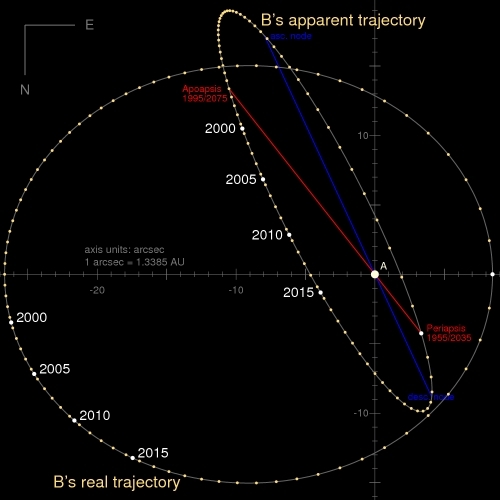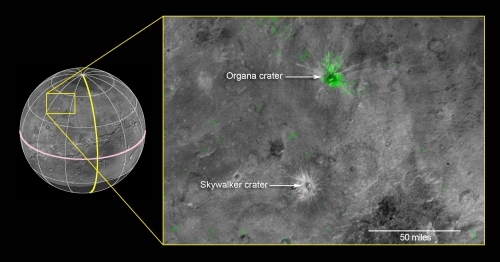Paul Gilster's Blog, page 165
November 16, 2015
Pluto’s Unexpected Complexities
Keeping up with a site like this can be a daunting task, especially when intriguing papers can pop up at any time and announcements of new finds by our spacecraft come in clusters. But site maintenance itself can be tricky. Recently Centauri Dreams regular Tom Mazanec wrote in with a project to be added to the links on the home page and before long, with my encouragement, he had sent a number of solid suggestions on exoplanet projects both Earth- and space-based, most of which have now been added. My thanks to Tom and all those who have at various times caught a broken link or added a suggestion for new links or stories.
We begin the week looking at work discussed at the Division for Planetary Sciences meeting in Maryland, starting with the continuing bounty coming in from New Horizons. I always like to quote Alan Stern, because as principal investigator for New Horizons, he is not only its chief spokesman but the guiding force that saw this mission become a reality. And I think he’s absolutely on target when he points to how fulsome a discovery Pluto is turning out to be:
“It’s hard to imagine how rapidly our view of Pluto and its moons are evolving as new data stream in each week,” says Stern. “As the discoveries pour in from those data, Pluto is becoming a star of the solar system. Moreover, I’d wager that for most planetary scientists, any one or two of our latest major findings on one world would be considered astounding. To have them all is simply incredible.”
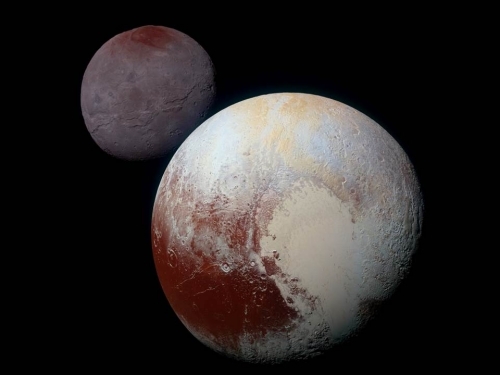
Image: Pluto and Charon are revealing themselves as worlds of profound complexity. Credit: NASA/Johns Hopkins University Applied Physics Laboratory/Southwest Research Institute.
All this with a flyby, leading me to wonder what we might find with a Pluto orbiter.
Think about Voyager. It opened our eyes to new worlds for this first time. It flew by Io and gave us active volcanoes. It flew by Triton and we saw weird ‘cantaloupe terrain’ and nitrogen geysers. All these stay fixed in my mind as I remember first learning about them. But what New Horizons is showing us ranges from bizarre moons to possible ice volcanoes, the huge satellite Charon in a system that is practically a binary ‘planet,’ and surface features that tell us about an active world that was once thought to be inert. Who thought Pluto/Charon would be this complex!
Wright Mons and Piccard Mons, as it turns out, each appear to have a hole at their summit, the signature of a volcano, but one expected to cough up water ice, nitrogen, ammonia or methane in a melted slurry rather than lava. We can’t push this too far, because on a world about which we have so much to learn, we may be in for yet another surprise. And Oliver White, a postdoctoral researcher at NASA Ames, points out another of the unknowns:
“If they are volcanic, then the summit depression would likely have formed via collapse as material is erupted from underneath. The strange hummocky texture of the mountain flanks may represent volcanic flows of some sort that have travelled down from the summit region and onto the plains beyond, but why they are hummocky, and what they are made of, we don’t yet know.”
Image: Scientists using New Horizons images of Pluto’s surface to make 3-D topographic maps have discovered that two of Pluto’s mountains, informally named Wright Mons and Piccard Mons, could possibly be ice volcanoes. The color is shown to depict changes in elevation, with blue indicating lower terrain and brown showing higher elevation; green terrains are at intermediate heights. Credit: NASA/Johns Hopkins University Applied Physics Laboratory/Southwest Research Institute.
As this JHU/APL news release makes clear, Pluto’s surface is also showing us far more textures than we might have expected. Why do we see so few small craters? Neither Pluto nor Charon give us many of these, casting doubt on the older model of Kuiper Belt objects formed by the accumulation of small objects. Now you can see why 2014 MU69 is beginning to loom so large. This KBO may be a pristine primordial planetesimal, the first ever to be explored. Assuming the New Horizons mission is extended, a flyby of 2014 MU69 will give us another look at a class of objects that may have been formed quickly and at close to their current size.
But we still have a lot of explaining to do re Pluto’s surface itself. Trying to determine the age of a surface is often a matter of counting the crater impacts to see what has accumulated over time (think of the relatively smooth surface of Europa, which indicates continuing resurfacing that obscures impacts). On Pluto, we do find surfaces that point to the earliest era of the Solar System four billion years ago, but we also see things like Sputnik Planum, whose smooth and impact-free terrain looks to have been formed within the past ten million years, an eyeblink in astronomical time.

Image: A slide from Oliver White’s presentation at DPS, showing crater densities on Pluto’s surface. Credit: NASA/Johns Hopkins University Applied Physics Laboratory/Southwest Research Institute.
Other terrains on Pluto look to be somewhere in between, with evidence of cratering extending back not nearly as far as the oldest areas. So is Sputnik Planum, which is on the left of Pluto’s heart-shaped feature, an anomaly, or a marker for a surface that has been geologically active for much of its history? We’re looking at evidence for how objects in the outer Solar System formed, again a splendid reason to back the extension of New Horizons to 2014 MU69.
More on Pluto/Charon and the findings discussed at the DPS meeting tomorrow.






November 13, 2015
The Initiative for Interstellar Studies: A Three Year Update
Kelvin Long is chief editor of the Journal of the British Interplanetary Society and the author of Deep Space Propulsion (Springer, 2011). A founder and first project leader of Project Icarus, the ongoing re-design of the Project Daedalus starship, Kelvin is also a co-founder of the non-profit Icarus Interstellar. He now serves as executive director of the Institute for Interstellar Studies, an organization whose mission (‘Scientia ad Sidera: Knowledge to the Stars’) he describes in the following essay.
by Kelvin F. Long
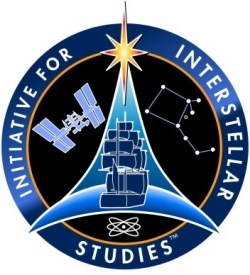
The Initiative for Interstellar Studies (i4is) is a not-for-profit foundational institute incorporated in the United Kingdom with the mandate to develop interstellar capabilities. We at the initiative just successfully passed our third anniversary since our founding. We began work in August 2012 and went live on the 12th September 2012. Shortly after, we ratified our purpose through our innovative logo, and our mission and vision statements. And today we are focused on the launch of our innovative new educational course titled ‘Starship Engineer’. We are piloting the first version of this in London during November, and we hope some of you will join us: http://i4is.org/news/starship_engineer
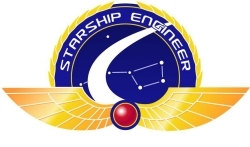
But first, it is worth just reminding the readers what we are really about. The mission of i4is is to foster and promote education, knowledge and technical capabilities which lead to designs, technologies or enterprise that will enable the construction and launch of interstellar spacecraft. The vision of i4is is to aspire towards an optimistic future for humans on Earth and in space. Our bold vision is to be an organisation that is central to catalysing the conditions in society over the next century to enable robotic and human exploration of the frontier beyond our Solar System and to other stars, as part of a long-term enduring strategy and towards a sustainable space-based economy. Our motto is “Scientia ad sidera” (knowledge to the stars) and our philosophy of approach is “Starships in our Lifetime”. In addition to this, we also spent weeks writing our own bespoke articles of association, which forms our effective constitution as a company limited by guarantee but not having a share capital – which means we are a not-for-profit entity. In addition, our team produced a ‘founding Declaration’ which sets out what we believe and are working towards. The full text of this can be read here: http://i4is.org/the-starship-log/foundations
So how far have we got in the constitution of the world’s first ever foundational institute dedicated to the goal of the stars? The Initiative for Interstellar Studies is led by a board of directors for which I serve as its Executive Director, supported by the Deputy Directors Rob Swinney and Andreas Hein. We are also supported by our international advisory committee which is chaired by Professor Gregory Matloff and deputy Professor Chris Welch. We have various committees, including a marketing committee and a finance committee, which ensures we are fiscally compliant and ethical? But our activity based committee’s number a few, and I shall give a brief synopsis of each in turn along with their achievements to date?
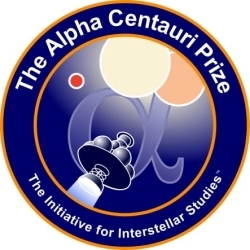
The Alpha Centauri Prize Committee has the purpose of rewarding success and incentivising progress in activities related to interstellar studies. So far the committee has given out several awards for University students associated with their thesis projects, or for internal members for work that they have done to assist our mission that goes above and beyond what is expected of them. We have received sponsorship from several external organisations to fund those awards. We seek to establish the Alpha Centauri Prize awards as the standard by which all of our progress is measured.
The Educational Academy Committee is chaired by Rob Swinney and has the purpose of fostering educational abilities to conduct research relating to a broad set of subjects pertaining to interstellar studies, associated sciences and the arts. The committee has undergone much public outreach work, working with schools and universities, particularly across the UK.
The largest activity of this committee is in working with the International Space University in Strasbourg, and in particular with its Master’s Director Professor Chris Welch, who is a continued inspiration not just for the students but for all of us in his steadfast support of our ambitious efforts. Within this co-operative relationship, for which we have signed a Memorandum of Understanding, some of our projects have included “Autonomous Space Colony Construction” authored by Michio Hirai, which considered the manufacture of large structures in space; “Agriculture Design Trade-offs for Space Colony Feasibility”, authored by Erik Franks, which discussed farming methods in spaceflight; “Review of the Deceleration Options for a Robotic Interstellar Spacecraft Entering the System of Another Star”, authored by Wei Wang; “The Oculus Project: Solar Sailing to Discover Exoplanets at the Center of Our Galaxy”, authored by Piotr Murzionak, which looked at a gravitational lensing mission based on the ideas of the pioneer Claudio Maccone; “Jude: Solar Sailing A Low Mass Payload to Alpha Centauri-B”, authored by James Harpur, which considered an interstellar solar sail mission. The committee has also created a fun educational exam paper, which we call the ‘interstellar minimum’ – dare you have a go at it? http://i4is.org/the-starship-log/interstellar-minimum
Our biggest technical and educational accomplishment working with the International Space University has been the initiation and completion of a world ship project titled “Astra Planeta” and you can read a copy here: https://isulibrary.isunet.edu/opac/index.php?lvl=notice_display&id=9454].
This project was selected as one of the few team projects that the ISU runs each year and it involved over 20 Master’s students. The team also looked at the issues of creating a strategic and technological roadmap for a world ship. But the nice thing about this project, is that it also got supported by representatives from the Tennessee Valley Interstellar Workshop and Icarus Interstellar – so it may be one of the first successful pan-interstellar community projects, and is perhaps a model for the future.
The Technical Research Committee is chaired by Andreas Hein and has the purpose of conducting innovative theoretical and experimental research and development across the broad spectrum of issues relating to interstellar studies, associated sciences and the arts.
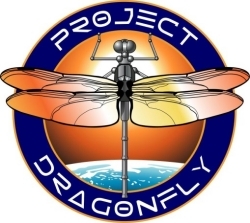
The committee’s flagship initiative is Project Dragonfly, which seeks to develop laser-sail propulsion capabilities based on the original ideas of Robert Forward. In the summer, the team ran a Kickstarter award and successfully won over $10,000.
This helped to fund a university affiliated design competition, which included participating teams from Cairo University, Egypt; University of California Santa Barbara, USA; Technical University of Munich, Germany and CranSEDS which involved students from Cranfield University in the UK, Skoltech in Russia and UPS in France. The University of Munich team won the competition with their innovative sail design. The four reports submitted by these teams were highly comprehensive and had to adhere to detailed competition requirements. To celebrate the award, the space artist David A Hardy was commissioned to produce an inspirational piece of art work of the winning design. The Technical Committee is now working on a technology roadmap focussed around the laser-sail technologies and this includes the consideration of actual space missions for the near future.
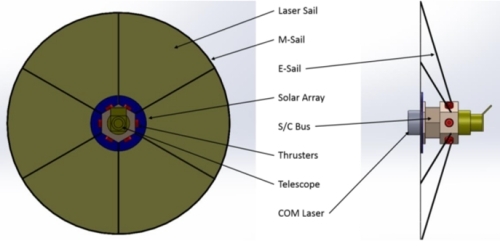
Image: Schematic of the winning Project Dragonfly design.
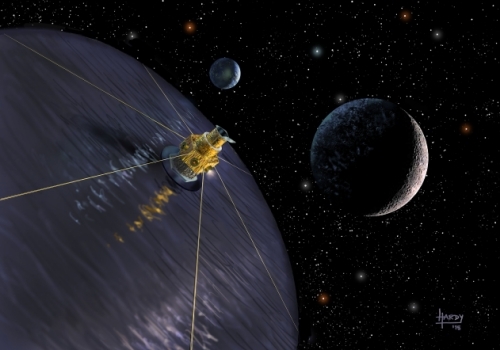
Image: David A Hardy commissioned art work of the winning laser-sail design for project Dragonfly.
The committee is also chairing several projects and this has already led to several reports. This includes “Project Sentinel” authored by Sissi Enestam, which described research into emission signals from different potential advanced space transportation systems as a contribution to SETI; “Space Eternal Memory” authored by Melissa Guzman which described methods of preserving and storing information on long duration deep space missions; “Project BAIR: the Black Hole Augmented Interstellar Rocket”, authored by Andrew Alexander, which discussed a black hole engine that utilised the Hawking radiation effect; “Program to Characterise the Local Stellar Environment” authored by Shambo Bhattacharjee. The committee is also currently launching a project relating to von Neumann machines and the Universal Constructor Project. The vision is to enable small interstellar probes to have the capability to build space infrastructures autonomously.
The Sustainability & Research Committee is chaired by Professor Rachel Armstrong and has the purpose of seeking space-based technological solutions to solving problems on Earth and in space, human made or environmental, and improving the human condition and harmonising cultural relations. Through this committee we have begun a relationship with a team of architects and initiated discussions on innovative technologies for the future that we can bring to our metropolis. The committee has also instigated the exciting ‘Starship Cities’ programmes, which seeks to develop the technologies for our society that can truly prepare us for the world ship journeys of the future. This includes looking at living architecture technologies such as protocells, and the ability to utilise them as a form of programmable matter and as a mechanism to simulate biological computing. In the last year the committee also completed a project with the International Space University titled “Biological Life Support Systems for Future Spaceflight Missions” authored by Brian Ramos. The committee is also looking at an innovative experimental architectural platform, upon which many types of experiments could be conducted on an iterative learning basis.
The Business Enterprise Committee is chaired by myself and has the purpose of encouraging entrepreneurship and business innovation initiatives related to the objects. We are currently exploring models for nurturing start-ups and aiming to develop a facilitation scheme over the next year. In addition, the committee is also in discussions with various private inventors about bringing potential products to market to benefit the community. One new company for which we have helped to nurture to fruition is Nebula Sciences (www.nebulasciences.com). This is a company led by Sam Harrison, who also serves on our Enterprise Committee, and conducts high altitude balloon launches into the upper stratosphere. That company is now working with multiple aerospace and marketing ventures throughout the world. The same team earlier placed the i4is logo at 89,000 ft, which was a milestone achievement for us, and demonstrates we are not just talking about theoretical developments.
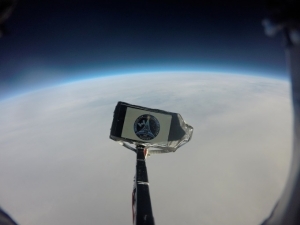
Image: The i4is Logo at 89,000 ft in the stratosphere
As of our three year anniversary, our team has published over 100 papers, reports, articles and essays, has given over 50 presentations, has produced nearly 100 external and internal blog articles, has held over 30 formal team meetings and around 100 informal team meetings, has been involved with over 50 other external organisations, has participated in over 40 different international events, and today has around 70 people directly involved in our activities in one form or another. We have had media articles in multiple international publications and have participated in online podcasts and radio shows. We have attended or presented at events across the globe, throughout the United Kingdom, Europe and the United States. As a part of our participating in the London World Science Fiction convention 2014, our team also built a 4 m tall monolith in what may be a world record (anyone?). Our packed out session at this exciting venue included talks from the world renowned science fiction authors Gregory Benford, Stephen Baxter and Alastair Reynolds.
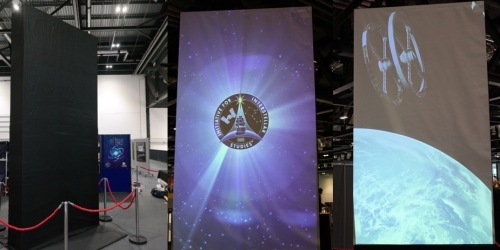
Image: Our Monolith displayed at Loncon3.
We have produced much of our own merchandise including t-shirts, post-cards and a calendar. One of our proudest and longest running achievement is the publication of our popular magazine Principium, and we are currently working on our twelfth issue. This is a popular publication for the community, and we always try to have an article on other organisations activities to help promote their work.
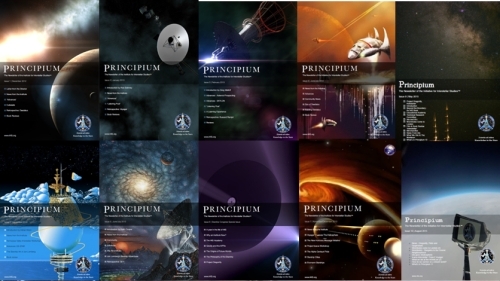
Image: Principium, the popular magazine of i4is.
We also have published our very own book “Beyond the Boundary” which had contributions from other 20 different authors associated with our subject [http://www.lulu.com/shop/http://www.lulu.com/shop/kelvin-long/beyond-the-boundary/hardcover/product-22028046.html]. And just to show that we are technologically minded, we have also developed our very own educational iPhone app. We have also been working with the inspirational artist and musician Alex Storer, and we are now on our fourth interstellar themed music album. This all proves we are engaging the both the arts and the sciences as we attempt to communicate the vision of interstellar travel. We have also recently just launched our own academic journal, Axiom, and we are now working on our second issue.
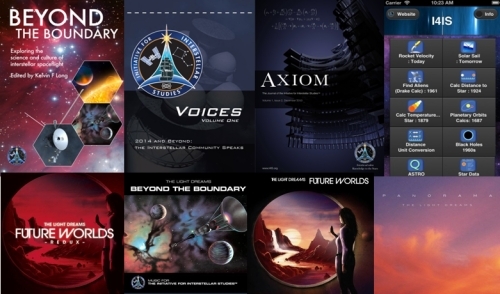
Image: Music albums, a journal and smartphone app of i4is.
So what about the future? Well, we are currently looking at facilities to host our Head Quarters and our team has visited many locations over the last couple of years and we are excited about the prospect of hosting interstellar events from such a facility. We are also working on another volume of the “Beyond the Boundary” book, as well as more issues of Principium and Axiom. We continue to attend events and this month we are attending Novacon, a science fiction convention held in Nottingham, UK, every year. Our team are busy working on papers for journals and various research projects from which we hope to see progress towards our goal made. We have also recently launched our supporting membership scheme (get in touch if you want to join) and we are planning to extend this in 2016. We are also keen to recruit more active volunteers to help out with our many activities.
One of the things I am personally keen to do in the future is to address how we can take this interstellar community onto the next level. That is, towards a path of constructive co-operation, resource sharing, and more focussed goal setting through inspirational leadership. One proposal I have made towards this, is the formation of an International Interstellar Committee, which would hold a bi-annual interstellar conference for which all of the community would help organise and participate in. Such a body would contain individual organisational membership, preserving their individual identifies and self-autonomy, whilst facilitating a global voice and finding synergies in strategies. It is my opinion, that such an entity may be needed if we are to find ways of harmonising relationships among different groups, but for all have their hearts set on the same goal.
Some still view our endeavours as premature, given the state of human space exploration to date. But I rather believe that now more than ever, there is the need for a visionary stretch goal to focus the energies of our fragmented civilisation. The vision of the stars gives us such promise, about the discovery of other worlds or new life forms. Its such an exciting journey to be a part of and it also has transformation potential for human civilisation, so that we can start to address the universe on its own terms, whether we live in a crowded galaxy, or if we are the only intelligent life out there. I for sure, would like to find out – so let’s build those starships in our lifetime, and go forth with less of our weaknesses and more of our strengths, as a unified people, embracing discovery and adventure as a primary goal. Personally, I can’t think of anything more fulfilling to dedicate one’s life too. At the Initiative for Interstellar Studies, we are making some progress towards that goal.






November 12, 2015
The Most Distant Dwarf Planet Yet
Back in the days when Clyde Tombaugh was using a blink comparator to search for ‘Planet X,’ finding a new object in the outer Solar System was highly unusual. Uranus had been found in 1781, Neptune in 1846, and I suppose I should add Ceres in 1801, although it’s a good deal closer than the other two. The real point is that the Solar System seemed straightforward in Clyde Tombaugh’s day. There were eight planets and an asteroid belt. It wouldn’t be until 1943 that Kenneth Edgeworth argued that the outer system might have ‘a very large number of comparatively small bodies,’ with Gerard Kuiper publishing his own speculations in 1951.
Estonian astronomer Ernst Öpik first described what we now know as the Oort Cloud in 1932, with Jan Oort, a Dutch astronomer, reviving the idea in 1950. The Oort Cloud was a way to explain why comets behave the way they do. Oort believed that there must be a cometary ‘reservoir’ far away from the Sun — he chose 20,000 AU as a likely range because of the number of long period comets with aphelia at approximately that distance. Moreover, long-period comets seemed to come from all directions of the sky. As we’ve refined the idea and the numbers, we’ve begun to see just how vast the Solar System really is.
None of this is to take anything away from the discovery of the small world called V774104, announced yesterday at the Division for Planetary Sciences meeting in Washington, DC. Astronomer Scott Sheppard (Carnegie Institution for Science) and Chad Trujillo (Gemini Observatory, HI) have found a world 15.4 billion kilometers out, which works out to 103 AU and makes V774104 the most distant dwarf planet known, fully three times further from the Sun than Pluto. In Tombaugh’s day, such a discovery would have been front page news. Today we’ve come to assume that there are a lot of dwarf worlds out there, and expectations are that as our equipment improves, we’ll find plenty more.
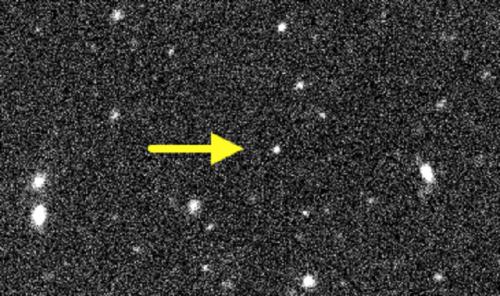
Image: A dot moving (slowly) across background stars, V774104 was found about 15 degrees off the ecliptic. Credit: Subaru Telescope by Scott Sheppard, Chad Trujillo, and David Tholen.
V774104 is currently estimated to be between 500 and 1000 kilometers in diameter, less than half Pluto’s size. Just how significant it is in the larger scheme of things has yet to be determined because we’re not yet sure about the parameters of its orbit. Is it, at 103 AU, close to aphelion, and will it eventually swing back toward Neptune, making its orbit the likely result of a gravitational encounter with that planet? Or is V774104 actually something far more unusual, a world similar to Sedna and VP113 in being a possible member of the inner Oort Cloud?
Neither Sedna nor VP113 comes close enough to the Sun to experience gravitational effects from the giant planets. In fact, both stay outside 50 AU, thought to be the outer edge of the Kuiper Belt, and have aphelia as distant as 1000 AU. Colin at the Armagh Planetarium site notes the problem in V774104: Could a Dark World Put a New Light on Solar System History?:
…the current highly elliptical orbits of Sednoids cannot be their original orbits, the chance of smaller bodies in such eccentric paths accreting into objects hundreds of kilometres across is fantastically low. Sednoids must have originally formed in relatively circular orbits, possibly in the Oort Cloud.
So how did they get where they are today? One possibility to explain their orbits is that they reflect conditions in the Solar System’s infancy, when the young Sun was in a local environment rich in nearby stars. The other possibility is one that Percival Lowell would have loved. There may be a large, rocky planet out there that has elongated previously circular orbits.
The data from the 8-meter Subaru instrument in Hawaii that produced V774104 have also yielded a number of other objects roughly 80 to 90 AU from the Sun, all of which will need lengthy follow-up study to clarify the nature of their orbits. Like V774104, any of these might join Sedna and VP113 in never coming closer to the Sun than 50 AU. We may be about to see a surge in the numbers of dwarf worlds in this unusual category. Explaining why a region once thought to be empty is not should occupy astronomers and theorists for years to come.






November 11, 2015
A Relatively Nearby Earth-Sized Planet
Given my abiding interest in red dwarf stars and the planets that circle them, I always keep an eye on what’s happening with the MEarth project. Two arrays of robotically controlled telescopes are involved in MEarth (pronounced ‘mirth’), one at the Fred Lawrence Whipple Observatory on Mt. Hopkins (AZ), the other a cluster of eight at the Cerro Tololo Inter-American Observatory in Chile. Both these arrays are controlled from MEarth’s offices in Cambridge (MA). MEarth is all about observing nearby M-dwarfs in the hunt for Earth-class planets.
My fascination in these stars is simply a result of the numbers. We’ve learned that M-dwarfs comprise as much as 80 percent of the stars in the Milky Way. Earth is not, in other words, orbiting the most common type of star out there. We also know that M-dwarfs host planets. If we learn that conditions on such worlds can support life, then we’ve dramatically expanded the search space for astrobiology. The prospect of a living world, probably tidally locked to its star, conjures images strange and wonderful, a world where shadows are permanent and half of the planet is an ice-covered waste, as Stephen Baxter recently portrayed in a planet called ‘Per Ardua’ that circles Proxima Centauri in his novel Ultima (Roc, 2015).
The latest news from MEarth comes out of MEarth-South, whose 40-centimeter instruments have detected an interesting light curve around the star GJ 1132, finding a dip of approximately 0.3 percent in the starlight. The signal, confirmed by other instruments in Chile, flags a planet that is roughly 1.2 times the size of the Earth, in a tight 1.6-day orbit. Given the star’s radius and the amount of light it blocks, researchers led by Zachory Berta-Thompson (MIT) calculate this is a planet with about 1.6 times Earth’s mass, a world that may well be rocky.

Image: In this artist’s rendering of GJ 1132b, a rocky exoplanet very similar to Earth in size and mass, circles a red dwarf star. GJ 1132b is relatively cool (about 226 degrees C) and could potentially host an atmosphere. At a distance of only 39 light-years, it will be a prime target for additional study with Hubble and future observatories like the Giant Magellan Telescope. Credit: Dana Berry.
The world is probably tidally locked. And life on GJ 1132b looks to be unlikely, given an estimated average temperature of 500 K (226 degrees Celsius). Says Berta-Thompson:
“The temperature of the planet is about as hot as your oven will go, so it’s like burnt-cookie hot. It’s too hot to be habitable — there’s no way there’s liquid water on the surface. But it is a lot cooler than the other rocky planets that we know of.”
That’s a useful fact because while surface conditions appear inimical to life, the planet is cool enough to retain a substantial atmosphere. GJ 1132 is a mere 39 light years from Earth, making it the closest Earth-sized exoplanet yet discovered. Recently we’ve been discussing the next generation of space telescopes, and now we find a world that will surely be a target for scrutiny, especially by the James Webb Space Telescope, which should be able to analyze the chemical constituents of the planet’s atmosphere and even detect the patterns of its winds.
“If we find this pretty hot planet has managed to hang onto its atmosphere over the billions of years it’s been around, that bodes well for the long-term goal of studying cooler planets that could have life,” adds Berta-Thompson. “We finally have a target to point our telescopes at, and [can] dig much deeper into the workings of a rocky exoplanet, and what makes it tick.”
Berta-Thompson points out that some 500 star systems are known to be closer to us than GJ 1132, and instruments like TESS (Transiting Exoplanet Survey Satellite) and CHEOPS (Characterizing Exoplanets Satellite), both scheduled for launch in 2017, will help us study many more targets. Learning how to analyze the atmospheres of nearby worlds is critical for our investigations into exoplanetary life. Planets like GJ 1132b will be useful in refining our tools as we begin to turn them to worlds with more condign prospects for living things.
The paper is Berta-Thompson et al., “A rocky planet transiting a nearby low-mass star,” Nature 527 (12 November 2015), 204–207 (abstract).






November 10, 2015
Quantifying KIC 8462852 Power Beaming
Plasma physicist James Benford, CEO of Microwave Sciences, is well known here on Centauri Dreams. Today he is joined by his son Dominic, whose work focuses on the development of ultrasensitive technologies for far-infrared through millimeter-wave astronomy. The younger Dr. Benford is Program Scientist for NASA’s WFIRST mission, which is designed to conduct major surveys in the near-infrared to answer fundamental questions on the nature of dark energy, the distribution of dark matter, the occurrence of planets around other stars, and even to enable the direct imaging of planetary systems. Previously, Dominic was Chief Scientist for the Cosmic Origins Program Office, as well as Deputy Mission Scientist for WISE, the Wide-field Infrared Survey Explorer. In today’s entry, the Benfords look at the SETI Institute’s recent observations of KIC 8462852 and analyze the detectability of power beaming at these distances.
by James and Dominic Benford

The recent report from the SETI Institute of radio observations of the anomalous star KIC 8462852 has immediate implications. That report concluded that, using the Allen Array, no narrowband radio signals were found above a few hundred Janskys in 1 Hz channels and no “wideband” signals above 100 Janskys are seen in 100 kHz channels. This is for observations taking place for 2 weeks, observing half the time. This implies about 180 hours of observations, although only about 1% of the time is spent at any individual frequency.
The purpose of the observations is to see whether the anomalous star is the site of a super-civilization that might be incidentally radiating sufficient power that we can observe, i.e., leakage radiation. They might even be intentionally producing signals for us to detect. The easiest way to do that is to ‘piggyback’, to put a message onto the power beams.
The thresholds they have reported, above which no signals are present, have implications for the presence of power beams in the anomalous star system. Beaming power on astronomical scales has been a frequent topic on this site and it has long been pointed out that the beaming of power for various purposes could be observable at astronomical distances.
The missions suggested for power beaming involve Earth–to–space applications such as launching spacecraft to orbit or raising satellites from a lower orbit to a higher one. Several workers have studied interplanetary missions, meaning space–to–space transfers of cargo. Finally, launch into the outer solar system and for interstellar precursors and ultimately for starships has also been quantified.
We have examined the thresholds in light of concepts proposed for beaming power in and around our solar system. By comparing the reported thresholds set by the SETI Institute, the non-observation of leakage signals at their stated thresholds implies the following:
Orbit raising missions, which require lower power, are not detectable at the thresholds of the Allen Array.
Launch from a planetary surface into orbits would be bright enough to be seen by the 100 kHz observations. However, the narrow bandwidth 1 Hz survey would not see them.
Interplanetary transfers by beam-driven sails should be detectable in their observations, but are not seen. This is for both the narrow 1 Hz and for the “wideband” 100 kHz observations.
Starships launched by power beams with beamwidths that we happen to fall within would be detectable, but are not seen.
These results must be qualified by noting:
Power beaming is not an isotropic endeavor, and so the geometry of the transmitter and the intended recipient will produce a conjunction from our point of view only episodically. The observations were conducted for only a limited time and further observations would provide a more stringent constraint.
Even the “wideband” observation is actually quite narrow compared with the kinds of sources that would be used in power beams, based on our current understanding of microwave physics. For the applications discussed here, the 100 kHz bandwidth observed would be about 10 to 100 millionths of the center frequency of the Beamer. But high-power devices are inherently not designed for such narrow bandwidths.
The frequencies we would use for power beaming are in the millimeter band, so are outside the microwave range the Allen Array observed.
Therefore the observations by the Allen Array are not sufficiently broad to produce firm conclusions about realistic Beamers.
Readers are encouraged to consult the original paper: Harp et al., “Radio SETI Observations of the Anomalous Star KIC 8462852” (preprint). Previous discussions on this matter can be found in the following reports:
“A Path Forward for Beamed Sails”: http://www.centauri-dreams.org/?p=20962
“Seeing Alien Power Beaming”: http://www.centauri-dreams.org/?p=34133
“Microwave Beaming: A Fast Sail to Mars”: http://www.centauri-dreams.org/?p=1176
“The Case for Beamed Sails”: http://www.centauri-dreams.org/?p=20924






November 9, 2015
Alpha Centauri Planet Reconsidered
Finding a habitable world around any one of the three Alpha Centauri stars would be huge. If the closest of all stellar systems offered a blue and green target with an atmosphere showing biosignatures, interest in finding a way to get there would be intense. Draw in the general public and there is a good chance that funding levels for exoplanet research as well as the myriad issues involving deep space technologies would increase. Alpha Centauri planets are a big deal.
The problem is, we have yet to confirm one. Proxima Centauri continues to be under scrutiny, but the best we can do at this point is rule out certain configurations. It appears unlikely, as per the work of Michael Endl (UT-Austin) and Martin Kürster (Max-Planck-Institut für Astronomie), that any planet of Neptune mass or above exists within 1 AU of the star. Moreover, no ‘super-Earths’ have been detected in orbits with a period of less than 100 days. This doesn’t rule out planets around Proxima, but if they are there, so far we don’t see them.
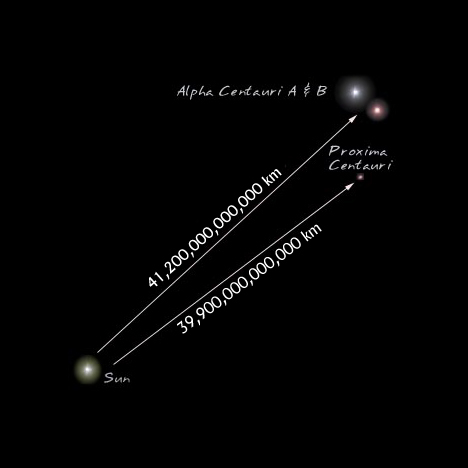
Image: The Alpha Centauri stellar system, consisting of the red dwarf Proxima Centauri and the two bright stars forming a close binary, Centauri A and B. Credit: NASA.
Centauri B, the K-class star in close proximity to G-class Centauri A, was much in the news a few years back with the announcement of Centauri Bb, a candidate world announced by Swiss planet hunters. This is radial velocity work based on data gathered by the HARPS (High Accuracy Radial Velocity Planetary Searcher) spectrometer on the 3.6-meter telescope at the European Southern Observatory in La Silla, Chile. The signal that Xavier Dumusque and team drew out of the data was 0.5 meters per second, a fine catch if confirmed.
What we thought we had in Centauri Bb was a mass just a little over the Earth’s and an orbit of a scant 3.24 days. As the blistering first planet detected around one of the Centauri stars, it would be a significant find even if it’s a long way from the temperate, life-sustaining world we’d like to find further out. The putative Centauri Bb supported the idea that there might be other planets there, and we’ve known since the work of Paul Wiegert and Matt Holman back in the 1990s that sustainable habitable zone orbits are possible around both the primary Alpha Centauri stars.
But Centauri Bb has remained controversial since Artie Hatzes (Thuringian State Observatory, Germany), using different data processing strategies, looked at the same data and found a signal he considered too noisy, indicating that what might be a planet might also be stellar activity on Centauri B itself. Debra Fischer’s team at Cerro Tololo Inter-American Observatory has also been studying Centauri Bb using the CHIRON spectrometer but has not been able to confirm it. And while a transit search using the Hubble Space Telescope did find a promising lightcurve (about which more in a moment), it couldn’t confirm Centauri Bb.
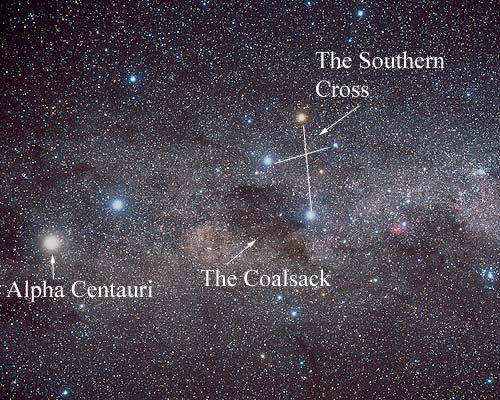
Image: Of the three stars of Alpha Centauri, the dimmest, Proxima Centauri, is actually the nearest star to the Earth. The two bright stars, Alpha Centauri A and B form a close binary system; they are separated by only 23 times the Earth – Sun distance. This is slightly greater than the distance between Uranus and the Sun. The Alpha Centauri system is not visible from much of the northern hemisphere. The image above shows this star system and other objects near it in the sky. Credit/copyright: Akira Fujii / David Malin Images.
Now we have a new paper from Vinesh Rajpaul (University of Oxford) and colleagues that makes Centauri Bb look more unlikely than ever. Rajpaul praises the thorough work of Xavier Dumusque and the team at the Geneva Observatory, but notes that their attempts to filter stellar activity out of their data evidently boosted other periodic signals that had nothing to do with a planet. The signal grows out of the time sampling, or ‘window function,’ of the data.
What is left behind is what the paper calls ‘the ‘ghost’ of a signal’ that was present all along. The paper argues that when a signal is sampled at discrete times (and the Dumusque team had to use the La Silla instrument only when it was not otherwise booked), periodicities can be imposed on the signal. Rajpaul was able to simulate a star with no planets, generating synthetic data out of which the exact same 3.24-day planetary signal emerged. The problem is particularly acute when working with planetary ‘signals’ as weak as these. From the paper:
D12’s data set [i.e., the data gathered by Dumusque and team] was particularly pathological because the window function happened to contain periodicities that coincided with the stellar rotation period of α Cen B, and its first harmonic; when these signals were filtered out, the significance of the 3.24 d signal was preferentially boosted.
All this is going to be quite useful if it helps us refine our techniques for identifying small planets. Rajpaul proposes that his team will carry out a new study of the spurious but coherent signals that can emerge from noisy datasets that should help us learn how to mitigate the problem:
We alluded to a number of other tests we believe worth carrying out when considering the reliability of planet detections from noisy, discretely-sampled signals. These include using the same model used to detect the planet instead to fit synthetic, planet-free data (with realistic covariance properties, and time sampling identical to the real data), and checking whether the ‘planet’ is still detected; comparing the strength of the planetary signal with similar Keplerian signals injected into the original observations; performing Bayesian model comparisons between planet and no-planet models; and checking how robust the planetary signal is to datapoints being removed from the observations.
Xavier Dumusque praises the Rajpaul team in this story in National Geographic, saying “This is really good work… We are not 100 percent sure, but probably the planet is not there.” We’re going to get a lot out of this investigation even though we lose Centauri Bb.
But back to that HST transit study run by Brice-Olivier Demory (University of Cambridge). I mentioned that it could detect no transit of Centauri Bb, which certainly fits with what we’ve just seen, but there was an interesting lightcurve suggesting a different possible planet, this one in an orbit that might range from 12 to 20 days. If this planet exists, radial velocity confirmation would be even more challenging than for Centauri Bb. Its signal, as Andrew LePage notes in The Discovery of Alpha Centauri Bb: Three Years Later, would be only half that of Centauri Bb.
LePage’s work at Drew ex Machina is definitive, and he has devoted a good deal of attention to Alpha Centauri. Here he explains why that second ‘planet’ is going to be so hard to spot:
Unfortunately with such a poorly constrained orbit, three weeks of nearly continuous photometric monitoring of α Centauri B will be required to confirm this hypothesis. HST is too busy to accommodate a dedicated search of this length and no other space telescope currently available is capable of making the needed observations. In addition, since the radial velocity signature for this planet would be expected to be maybe half that of α Centauri Bb, this method has little likelihood of providing independent confirmation of this sighting any time soon. Once again, we will have to wait for a few more years for new telescopes to become available such as NASA’s TESS (Transiting Exoplanet Survey Satellite) mission or ESA’s CHEOPS (Characterizing Exoplanets Satellite) which are both scheduled for launches in 2017 and may be capable of making the required observations of such a bright target.
Alpha Centauri is frustrating in many ways because you would expect the closest stellar system to have revealed more of its secrets by now. One of the problems, though, and a huge one, is that the angular separation (as viewed from Earth) of the primary Centauri stars has been decreasing as they move through their orbits. It won’t be until December of this year that they’ll reach minimum separation as seen from Earth. We’ll need to give Alpha Centauri a little time, in other words, before we can hope to get data on other possible worlds around Centauri B.
Image (click to enlarge): Apparent and true orbits of Alpha Centauri. The A component is held stationary and the relative orbital motion of the B component is shown. The apparent orbit (thin ellipse) is the shape of the orbit as seen by an observer on Earth. The true orbit is the shape of the orbit viewed perpendicular to the plane of the orbital motion. According to the radial velocity vs. time [10] the radial separation of A and B along the line of sight had reached a maximum in 2007 with B being behind A. The orbit is divided here into 80 points, each step refers to a timestep of approx. 0.99888 years or 364.84 days. Credit: Wikimedia Commons.
The Rajpaul paper is Rajpaul, Aigrain & Roberts, “Ghost in the time series: no planet for Alpha Cen B,” accepted for publication at Monthly Notices of the Royal Astronomical Society (preprint). The Hatzes paper is “Radial Velocity Detection of Earth-Mass Planets in the Presence of Activity Noise: The Case of α Centauri Bb”, The Astrophysical Journal, Vol. 770, No. 2, (2013) (preprint).






November 6, 2015
SETI: No Signal Detected from KIC 8462852
I’ve mentioned before that I think the name ‘Tabby’s Star’ is a wonderful addition to the catalog. It trips off the tongue so much more easily than the tongue-twisting KIC 8462852, and of course it honors the person who brought this unusual object to our attention, Yale University postdoc Tabetha Boyajian. 1480 light years away, Tabby’s Star is an F3 with a difference. It produces light curves showing objects transiting across its face, some of them quite large, and the search is on to find an explanation that fits within the realm of natural causes.
Five articles about Tabby’s Star have already appeared in these pages, with the most likely explanation being some kind of cometary activity, an answer that seems to satisfy no one. We’ve also consulted both Boyajian’s paper on the subject and a paper by Jason Wright and colleagues out of the Glimpsing Heat from Alien Technologies project at Penn State. The light curves we’re looking at do fit the scenario of a ‘Dyson swarm,’ a cluster of power-collecting surfaces that an advanced civilization might create to extract maximum energy from its star.
Thus we can’t rule out the possibility of an extraterrestrial civilization, but no one is claiming that we’ve found one. The point is that in terms of Dysonian SETI, which looks for signs of another civilization’s activity in our astronomical data, Tabby’s Star is the most interesting target we’ve found, so it only makes sense to investigate it. Assuming we do deduce a natural cause for its signature, we will have learned something about an unusual astrophysical process, and that is all to the good. The sole driver here is to investigate and find out what is happening.
The SETI Institute has a natural interest in all this and has been deploying the Allen Telescope Array on Tabby’s Star for more than two weeks. Now we have an update on what the Institute has found. The effort used the Array’s 42 antennas north of San Francisco to look for narrow-band signals (approximately 1 Hz in width) that could be part of an interstellar beacon. In general, SETI at radio and optical frequencies (SETI, that is, of the non-Dysonian kind) looks for this kind of signal, a deliberate attempt by a civilization to declare its presence.
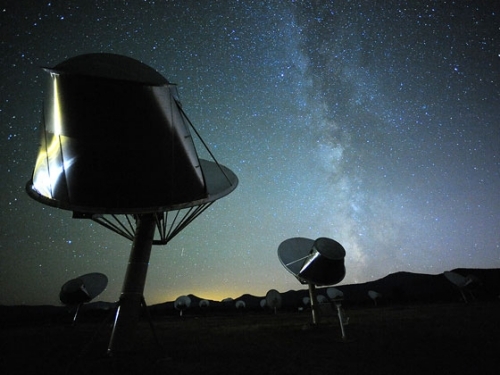
Image: Allen Telescope Array. Credit: Seth Shostak, SETI Institute.
But the SETI Institute also looked for broadband signals, an interesting choice. Here we are asking whether, if there really is an enormous astro-engineering effort going on around this star, there would be spacecraft sent out to service it. Our own investigations into quick travel around the Solar System point to microwave beaming as a feasible solution, the basis for an interplanetary infrastructure. Such intense microwave beams might well be visible, a kind of ‘leakage’ from the civilization’s activities that implies nothing about communication.
Here’s the result, from the SETI Institute’s paper on the work (Jy stands for jansky, a unit of density used in radio astronomy):
The observations presented here indicate no evidence for persistent technology-related signals in the microwave frequency range 1 – 10 GHz with threshold sensitivities of 180 – 300 Jy in a 1 Hz channel for signals with 0.01 – 100 Hz bandwidth, and 100 Jy in a 100 kHz channel from 0.1 – 100 MHz.
So no clear evidence for either kind of signal between 1 and 10 GHz. The paper goes on:
These limits correspond to isotropic radio transmitter powers of 4 – 7 1015 W and 1020 W for the narrowband and moderate band observations. These can be compared with Earth’s strongest transmitters, including the Arecibo Observatory’s planetary radar (2 1013 W EIRP [effective isotropically radiated power]). Clearly, the energy demands for a detectable signal from KIC 8462852 are far higher than this terrestrial example (largely as a consequence of the distance of this star).
What this initial search does is to place upper limits on anomalous emissions from Tabby’s Star. It tells us that we can rule out omnidirectional transmitters broadcasting narrow-band signals at approximately 100 times today’s total terrestrial energy usage, as well as broadband emissions of ten million times terrestrial energy usage. These numbers are high, as the Institute notes, but the paper goes on to say that required transmitter power for narrow-band signals could be reduced considerably if a signal were being beamed in our direction intentionally. It’s worth remembering, too, that any civilization of K2 status (capable of building a Dyson swarm) should have approximately 1027 watts to work with, the energy output of its star.
In any case, says Institute astronomer Seth Shostak, we keep looking:
“The history of astronomy tells us that every time we thought we had found a phenomenon due to the activities of extraterrestrials, we were wrong. But although it’s quite likely that this star’s strange behavior is due to nature, not aliens, it’s only prudent to check such things out.”
Exactly so. The authors add that the star will be the subject of observations for years to come.
Addendum: The Boquete Optical SETI Observatory in Panama is also going to be brought into the search, as per this story.
The paper is Harp et al., “Radio SETI Observations of the Anomalous Star KIC 8462852” (preprint). A SETI Institute news release is also available.






November 5, 2015
A 3D Look at GJ 1214b
An old friend used to chide me about the space program, asking good-naturedly enough why it mattered to travel nine years to get to a place like Pluto (this was not long after the New Horizons launch). ‘Just another rock,’ he would say. ‘Why go all that way to look at just another rock?’ Although we had many disagreements, Abe was one of the shrewdest people I’ve ever known. I had met him when he was in his sunset years, but in his prime he had run a large financial operation, been the subject of a story on the front page of the Wall Street Journal and had made a serious fortune in real estate speculation.
So what about this ‘just another rock’ meme? Abe died a few years back but I think about him in relation to things like yesterday’s story on Charon. The point is, it’s not just another rock. It’s this particular rock. And maybe it’s not a rock at all; maybe it’s a ball of icy slush. And maybe, as we’ve learned, it’s a seriously interesting thing that surpasses expectation. Each time we get to one of these places, or study a planet with transits and radial velocity methods, we’re seeing something never seen before. It may be able to teach us about conditions far different from those we experience and explain deep questions about the history of our own solar system.
Beyond that, each new ‘rock’ is part of a process of building understanding. We need to know what is around us because while we cannot solve all mysteries, we are compelled to solve the ones in front of us, the ones we can get to or develop the tools to investigate. The thing is, each time we go looking we seem to find something surprising, and then we need an answer for the conundrum. It’s a process that presumably began early in the development of our species.
I used to kid Abe by responding, ‘What does another dollar matter? It’s just another dollar.’ He got the point. Abe had a natural touch with money and knew how to make it multiply. Each new business venture was for him a kind of exploration. We just differed in the direction of our passions. I’ll take Charon or GJ 1214b over stock exchanges in New York or Tokyo, and that’s probably while you’ll never be reading about me on the front page of the Wall Street Journal.
An Exoplanet’s Clouds
So let’s talk about exoplanets. GJ 1214b is likewise ‘just another planet’ when viewed with the wrong filter. Viewed as we view things on Centauri Dreams, it’s one particular planet, and like so many we’ve found, it has its own set of things to teach us. Its star, an M-dwarf, is 42 light years away in the constellation Ophiuchus. Consider this planet a ‘mini-Neptune,’ one of the first discovered. What makes GJ 1214b so interesting is that it’s so close to our own system and gives us such a rich transit signature every 1.6 days.
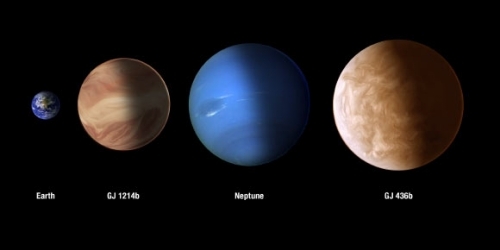
Image: Comparing the sizes of exoplanets GJ 436b and GJ 1214b with Earth and Neptune. Credit: NASA / ESA / A. Feild and G. Bacon, STScI.
We can use what is called transmission spectroscopy to study the atmospheres of places like this even though we can’t actually see the planet other than through its light curve. A planet passing in front of its star as seen from Earth offers us the opportunity to parse starlight that has been filtered through its atmosphere. The spectrum thus produced tells us about the composition of that atmosphere, its molecules and dust grains. It’s a method that has been used with great effect on worlds like HAT-P-11b and the ‘hot Jupiter’ HD 189733b.
The problem is, when we apply the techniques of transmission spectroscopy to GJ 1214b, nothing much happens. Studies using the Hubble instrument see little variation, a ‘flat spectrum’ that rules out an atmosphere of hydrogen, water, carbon dioxide or methane. Something in the planet’s atmosphere is evidently blocking out light. In a new paper, Benjamin Charnay (University of Washington), working with the university’s Victoria Meadows and several other researchers, has been attacking the problem, setting up models of varying atmospheric temperatures and composition that simulate a three-dimensional cloud structure.
Using a climate model developed by Charnay’s former research group in Paris, the scientist applied models previously used to study Titan to this intriguing exoplanet. GJ 1214b is close enough to its star that atmospheric temperatures are high, exceeding the boiling point of water. Clouds on a world like this would, Charnay believes, most likely be made of potassium chloride (KCl) or zinc sulfide (ZnS), lifted high into the atmosphere to produce such a flat spectrum. The model relies on a robust atmospheric circulation to boost these clouds to altitude.
But there is another potential source of GJ 1214b’s flat spectrum: A photochemical haze. Charnay is now looking at modeling hazes that could produce the same kind of spectrum. Data from the James Webb Space Telescope, scheduled to be launched in 2018, will be needed to rule out alternatives. Assuming 0.5 µm particles (necessary to produce the flat spectra observed), the paper finds that potassium chloride clouds produce a constant reflectivity at visible wavelengths, while zinc sulfide clouds do not absorb at 0.5 µm, producing a peak of reflectivity. Organic haze, on the other hand, strongly absorbs at short visible wavelengths.
A stratospheric thermal inversion should show up at infrared wavelengths. From the paper:
The observation of a few primary/secondary eclipses or full orbits by JWST could provide very precise spectra and phase curves revealing GJ1214b’s atmospheric composition and providing clues on the size and optical properties (i.e. absorbing or not) of clouds. Non-absorbing clouds would suggest KCl particles. Absorbing clouds would favor ZnS particles or organic haze. In that case, the best way for determining the composition of cloud particles would be direct imaging or secondary eclipses/phase curves of reflected light in the visible. The different clouds/haze have characteristic features in visible reflectivity spectra. Future large telescopes such as ELT may have the capabilities for measuring this.
Charnay’s model shows how potassium chloride or zinc sulfide clouds would be created and lifted into the upper atmosphere, while also predicting the effect the clouds would have on planetary weather. The atmospheric circulation in this model is strong enough to carry KCl particles to high altitude regions while producing a minimum of cloud cover at the equator.
Just another rock? Look what we’re doing here: We’re studying layers of atmosphere on a planet we cannot see by using the spectroscopic signatures produced by a star 42 light years from the Sun. In astronomical terms, of course, that’s close, and GJ 1214b’s proximity makes it ideal for the study of mini-Neptunes. Moreover, it may be useful for understanding how our own planet’s atmosphere has changed over time, as Charnay notes in this UW news release:
“Worlds like Titan and this exoplanet have complex atmospheric chemistry that might be closer to what early Earth’s atmosphere was like. We can learn a lot about how planetary atmospheres like ours form by looking at them.”
The trick is in knowing what to look for and developing the tools to investigate — later resources, both space- and ground-based, will then be brought to bear to further the analysis. Given the wild multiplicity of exoplanets, we’re sure to be applying lessons learned at GJ 1214b to other mini-Neptunes, and generalizing from there to broader models of atmospheric evolution. Uncovering things, learning, pushing deeper is a compulsive process. We all have our obsessions, but I can’t think of a better one than the drive to explain other worlds.
The paper is Charnay et al., “3D modeling of GJ1214b’s atmosphere: formation of inhomogeneous high clouds and observational implications,” Astrophysical Journal Letters, Volume 813, Number 1 (abstract / preprint).






November 4, 2015
Unusual Crater on Charon
Another surprise from New Horizons, in a year which will surely see a few more before it ends. After all, we have a long flow of data ahead as the spacecraft continues to return the information it gathered during the July flyby of Pluto/Charon. Now we focus on Charon and the crater being called Organa, which produced an anomaly when scientists studied the highest resolution infrared compositional scan of the moon available. This crater and some of the surrounding materials show infrared absorption at about 2.2 microns, indicating frozen ammonia.
Not far away on Charon’s Pluto-facing hemisphere is Skywalker crater, which under infrared scrutiny shows the same composition as the rest of Charon’s surface. Here water ice — not ammonia — dominates. As this JHU/APL news release notes, ammonia absorption was first detected on Charon as far back as 2000, but what we’re seeing here is unusually concentrated. In any case, why is Organa so different from Skywalker and the rest of Charon’s craters?
Image: This composite image is based on observations from the New Horizons Ralph/LEISA instrument made at 10:25 UT (6:25 a.m. EDT) on July 14, 2015, when New Horizons was 81,000 kilometers from Charon. The spatial resolution is 5 kilometers per pixel. The LEISA data were downlinked Oct. 1-4, 2015, and processed into a map of Charon’s 2.2 micron ammonia-ice absorption band. Long Range Reconnaissance Imager (LORRI) panchromatic images used as the background in this composite were taken about 8:33 UT (4:33 a.m. EDT) July 14 at a resolution of 0.9 kilometers per pixel and downlinked Oct. 5-6. The ammonia absorption map from LEISA is shown in green on the LORRI image. The region covered by the yellow box is 280 kilometers across. Credit: NASA/Johns Hopkins University Applied Physics Laboratory/Southwest Research Institute.
Organa and Skywalker are roughly the same size, about 5 kilometers in diameter, and both show the same ‘rays’ of ejected material, although Organa’s central areas are darker. But there seems to be no correlation: The ammonia-rich material extends beyond the dark area. One possibility is that the impactor that created Organa was rich in ammonia. An alternative posited by Will Grundy (New Horizons Composition team lead, Lowell Observatory) is that the crater could have been the result of an impact into a pocket of ammonia-rich subsurface ice.
“This is a fantastic discovery,” says Bill McKinnon (Washington University, St. Louis), deputy lead for the mission’s Geology, Geophysics and Imaging team. “Concentrated ammonia is a powerful antifreeze on icy worlds, and if the ammonia really is from Charon’s interior, it could help explain the formation of Charon’s surface by cryovolcanism, via the eruption of cold, ammonia-water magmas.”
Meanwhile, New Horizons has now completed the third of its four trajectory-adjusting maneuvers needed for intercept of Kuiper Belt object 2014 MU69. This was a 30-minute burn with the craft’s hydrazine thrusters and all indications are that it was successful. The fourth and final targeting maneuver is scheduled for today (November 4), although adjustments will be made later in the mission as more information about the KBO’s orbit is obtained. Remember that we only found 2014 MU69 in 2014, after a long search for a Kuiper Belt candidate.

Image: Projected route of NASA’s New Horizons spacecraft toward 2014 MU69, which orbits in the Kuiper Belt about 1.6 billion kilometers beyond Pluto. Planets are shown in their positions on Jan. 1, 2019, when New Horizons is projected to reach the small Kuiper Belt object. NASA must approve an extended mission for New Horizons to study the ancient KBO. Credit: JHU/APL.






November 3, 2015
Exoplanetology Beyond Kepler
Useful synergies continue to emerge among our instruments as we ponder the future of exoplanet studies. Consider the European Space Agency’s PLATO mission (PLAnetary Transits and Oscillations of stars). Operating from the L2 Lagrangian point, PLATO will use 34 telescopes and cameras on a field of view that includes a million stars, using transit photometry, as Kepler did, to find planetary signatures. Working at optical wavelengths, PLATO will look for nearby Earth-sized and ‘super-Earth’ planets in the habitable zone of their stars.
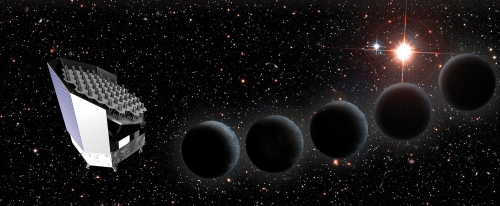
This mission is scheduled to be launched in 2024, an interesting date because it’s also the year that the European Extremely Large Telescope (E-ELT) is scheduled to see first light. Huge new installations like these, although ground-based, are so powerful that they should be able, with the help of adaptive optics, to study planetary atmospheres on the PLATO-discovered planets. Thus we get the best of both worlds, with repairable and upgradable ground telescopes fleshing out the data gathered by our space instruments, just as today we can use Kepler data to find planet candidates and then confirm them using radial velocity studies from the ground.
The TESS mission (Transiting Exoplanet Survey Satellite) launches earlier (probably in 2018) but offers the same kind of synergies with other instruments. Both TESS and PLATO, for example, will hand off data to the James Webb Space Telescope, scheduled for a 2018 launch. Here again we can look for deepened studies of the targets other missions have found. And in the process, we can be assured that we’ll enrichen our catalog of extrasolar worlds.
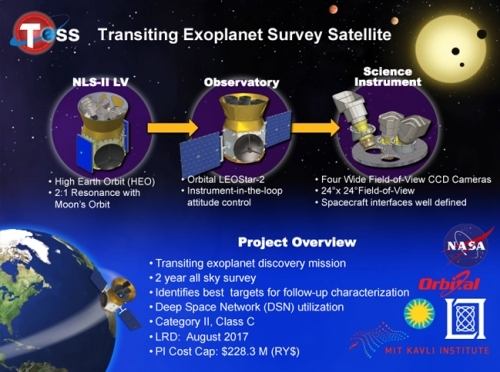
Just what we might find is the subject of new work by Michael Hippke (Institute for Data Analysis, Neukirchen-Vluyn, Germany) and Daniel Angerhausen, a postdoc at NASA GSFC. Writing in The Astrophysical Journal, the duo explain in one recent paper that while planets with sizes and orbits similar to Mars or Mercury will be out of reach (around solar-class stars, at any rate), planets the size of Venus or Earth should show up readily for TESS and PLATO. The optimum target for life-hunters, of course, is an Earth-class world in an Earth-like orbit, and both instruments are believed to be capable of finding these. From the paper:
In this work, we have shown that future photometry will be able to detect Earth- and Venus-analogues when transiting G-dwarfs like our Sun… Larger sized planets (> 2R⊕) will be detected in a single transit around G-dwarfs, in low stellar noise cases, and assuming one can find them in the first place. The search techniques for such single transits will require further research and validation, and will likely be performed remotely, due to the large storage requirements.
But Hippke and Angerhausen’s interests extend beyond planets. They believe that a large planet like Jupiter that has several large moons should produce a characteristic signature, allowing its ‘exomoons’ to be detected. The detection would be marginal, as Angerhausen explains: “We wouldn’t have a clear detection, and we wouldn’t be able to say whether the planet had a single large moon or a set of small ones, but the observation would provide a strong moon candidate for follow-up by other future facilities.”
Let me drop back quickly to one of Hippke’s papers from early 2015, which explored exomoon candidates from the Kepler data, using what is known as the orbital sampling effect, which stacks numerous planet transits and tries to extract an exomoon signature. In this paper, Hippke used numerical simulations to inject exomoon signals into real Kepler data. This is useful because it shows us that there is a size limit to what we can find, one that TESS and PLATO should be able to improve on. The paper finds that for suitable planets with orbits between 35 and 80 days, an exomoon’s detectable radius is approximately 2120 kilometers, or about a third the radius of Earth, while for longer period planets, even larger moons are the minimum.
Such moons go beyond what we generally see in our system, but as the paper notes:
…our solar system might not be the norm – we have no Hot Jupiters, warm Neptunes, or Super-Earths in our solar system, and thus no reference for typical moons around such planets. Also, there is a strong selection bias, based on the detection limits…, and in addition the simple fact that the strongest dips are most significant. The first moons to be found will likely be at the long (large/massive) end of exomoon distribution, as was the case for exoplanets.
Hippke is surely right that the first moons found will be at the larger end of the size range, just as the first exoplanets we detected were massive worlds in close orbits that were the easiest to see with our instruments. For more on Hippke’s work and the methods he employs, see the article he wrote for Centauri Dreams, Exomoons: A Data Search for the Orbital Sampling Effect and the Scatter Peak.
But back to the Hippke and Angerhausen paper I started with. It notes that while the detection of moons will remain problematic for planets analogous to those in our own system, moons around planets orbiting quiet M-dwarf stars should be easier to detect. This paper, “Photometry’s bright future: Detecting Solar System analogues with future space telescopes,” focuses in directly on the capabilities of instruments like TESS and PLATO in offering datasets beyond Kepler’s.
Here again the authors deploy the Orbital Sampling Effect:
The OSE can be used to detect a significant flux loss before and after the actual transit (if present), which might be indicative of an exomoon in transit. The basic idea is that at any given transit the moon(s) must be somewhere: They might transit before the planet, after the planet, or not at all – depending on the orbit configuration. But by stacking many such transits, one gets, on average, a flux loss before and a flux loss after the exoplanet transit.
And bear in mind that moons are only one of the things we might expect to extract from TESS and PLATO data. Right now we have one detected ring system, around the planet J1407b, a massive ring more than 200 times larger than Saturn’s. The authors show that a transiting planet with a ring system produces a definitive signal. Even Trojan asteroids, which lead and follow a planet by 60 degrees in its orbit, should be in range for detection. In a third paper, the authors use Kepler data, injecting synthetic Trojan light curves to search for the limits of detectability. From the paper:
Our result gives an upper limit to the average Trojan transiting area (per planet) corresponding to one body of radius < 460km at 2σ confidence. We find a significant Trojan-like signal in a sub-sample for planets with more (or larger) Trojans for periods >60 days.
The authors call these results tentative and suggest that improved data from TESS and PLATO should help us refine them. “As good as the Kepler data are, we’re really pushing them to the limit, so this is a very preliminary result,” adds Hippke in this NASA news release. “We’ve shown somewhat cautiously that it’s possible to detect Trojan asteroids, but we’ll have to wait for better data from TESS, PLATO and other missions to really nail that down.”
All of which tells us that we have much to expect from TESS and PLATO and the instruments that will subsequently home in on the targets they have provided. The papers are Hippke, “On the detection of Exomoons: A search in Kepler data for the orbital sampling effect and the scatter peak,” The Astrophysical Journal Vol. 806, No. 1 (abstract / preprint); Hippke and Angerhausen, “Photometry’s bright future: Detecting Solar System analogues with future space telescopes,” accepted at The Astrophysical Journal (preprint); and Hippke and Angerhausen, “A statistical search for a population of Exo-Trojans in the Kepler dataset,” accepted at The Astrophysical Journal (preprint).






Paul Gilster's Blog
- Paul Gilster's profile
- 7 followers



